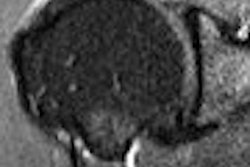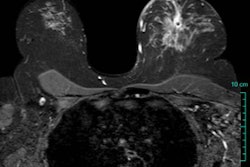Female patients are more likely to experience reactions to gadolinium-based contrast agents, especially as adults, according to a study in the December American Journal of Roentgenology. Although the majority of these reactions are quite mild, clinicians who perform contrast-enhanced MR studies should be prepared to manage them, stated the authors from the Ann Arbor-based University of Michigan Health System.
"For many years, gadolinium-containing contrast materials have been considered quite safe, with minimal associated risk. This position may be changing somewhat, however, with the recent recognition of an association between gadolinium-containing contrast agents and nephrogenic systemic fibrosis (NSF)," wrote Dr. Jonathan Dillman and colleagues, who are from the university's department of radiology and the section of pediatric radiology at the university-affiliated C.S. Mott Children's Hospital (AJR, December 2007, Vol. 189:6, pp. 1533-1539).
Dillman's group evaluated the frequency of acute reactions to IV-administered gadolinium-based agents in children and adults, and also sought to determine if there were presumed risk factors for these allergies.
The cohort for this retrospective study consisted of 13,344 pediatric patients and 65,009 adult patients who underwent contrast-enhanced MR between 2001 and 2006. Intravenous gadolinium-based agents were given to all patients. Contrast material reaction forms were completed for all patients, although the authors noted that in 44% of the cases the offending gadolinium-containing agent was not documented.
Only acute (occurring before the patient left the imaging department) reactions were included in this study; delayed reactions, such as NSF, and contrast extravasations were excluded. Acute reactions were categorized as mild, moderate, or severe based on the American College of Radiology (ACR) categories of reactions.
The following three contrast agents were used in both children and adults over the five-year period:
- Magnevist (gadopentetate DTPA, Berlex, Montville, NJ)
- MultiHance (gadobenate dimeglumine, Bracco Diagnostics, Princeton, NJ)
- OmniScan (gadodiamide, GE Healthcare, Chalfont St. Giles, U.K.)
Finally, the authors searched patient records for evidence of previous allergic responses to any contrast agent, documentation of medication given (corticosteroids, antihistamines) before gadolinium-based contrast administration, prior allergic reactions to noncontrast agents, and history of asthma.
According to the results, 54 (0.07%) acute allergic-like reactions were reported during the study period: six in children (0.04% of 13,344) and 48 in adults (0.07% in 65,009).
Out of 54 total reactions, 35 were in female patients and 19 were in male patients. The mean age of the adult patients was 47 years, while the mean age of the pediatric patients was nine months. The majority of these reactions (74%) were classified as mild (hives, sneezing, and nasal congestion). The four severe cases reported included reactions such as hypoxia, laryngeal edema, and facial angioedema.
"When combining both the pediatric and adult rates, 65% of reactions involved female patients, whereas only 35% of reactions involved males," Dillman's group noted. "The cause of such a difference between sexes is uncertain."
Another of the authors' observations was that 48% of the reactions came after the administration of gadopentetate DTPA. This may be because these linear ionic gadolinium chelates are considered less stable than cyclic ones, they suggested.
In addition, 50% of the patients who experienced an allergic reaction also had such risk factors as prior contrast agent reaction and a history of asthma.
In their AJR paper, the authors listed the various management protocols that can be followed to address these allergic reactions, ranging from no treatment to transferring the patient to the emergency department and administering diphenhydramine or epinephrine.
In an e-mail interview with AuntMinnie.com, Dillman discussed how the results of his group's study have impacted the way gadolinium administration is handled in his department.
AuntMinnie: Since your group's study was completed, have there been changes to the pre-MR screening procedure used at your institutions, especially in terms of assessing whether a patient has one of more of the risk factors that you mentioned in the article?
For years now we have routinely screened all patients who are about to undergo intravascular iodinated and gadolinium-containing contrast material administrations for a variety of risk factors. Such factors screened for include a history of prior allergic-like contrast material reaction, allergic or allergic-like reaction(s) to other substances, and recent or severe asthma.
If a patient has had a prior allergic-like reaction to a gadolinium-containing contrast agent, multiple or severe reactions to other substances (including iodinated contrast material), or a history of recent or severe asthma, then premedication with corticosteroid and antihistamine may be recommended prior to gadolinium-containing contrast material administration at our institution. This policy was in effect prior to this study.
We also screen patients about to undergo injections of iodinated contrast material or gadolinium-containing contrast agents for renal dysfunction, due to the risks of contrast-induced nephrotoxicity (CIN) and NSF.
The rigorousness with which we assess renal function in patients about to undergo contrast-enhanced MR examinations has increased substantially over the past year due to the recent concerns about NSF.
In those patients who do have risk factors, would you recommend an alternative imaging protocol (noncontrast MR or a different modality altogether)?
Premedication with corticosteroid and antihistamine is utilized at our institution prior to the administration of gadolinium-containing contrast material in patients that we believe are at substantially increased risk of allergic-like reaction. We typically do not readminister gadolinium-containing contrast material to patients with a history of prior severe reaction to these agents. In this setting, either unenhanced MRI or another imaging modality is typically employed. This is not dissimilar to how we manage patients with a history of iodinated contrast material allergic-like reaction.
The paper also states that the "offending" gadolinium-based contrast agent used for the MR study was not documented in 44% of the cases. Did this figure surprise you? And has there been any change in hospital policy regarding contrast medium documentation since your study?
We were indeed surprised. For these reactions, the contrast agent was not recorded on either our departmental contrast material reaction form or in the final imaging report. On most occasions, available records simply described the offending contrast agent as either "gad" or "gadolinium" (instead of a specific gadolinium-containing contrast agent).
As a result of this study, as well as recent concern regarding specific gadolinium-containing contrast agents and the development of NSF, we now require that the details pertaining to all intravascular contrast administrations be documented within the imaging report, including the specific contrast agent and dose.
By Shalmali Pal
AuntMinnie.com staff writer
December 21, 2007
Related Reading
Transglutaminases seen as 'missing link' in nephrogenic systemic fibrosis, October 18, 2007
MR experts take issue with FDA gadolinium warning, September 18, 2007
Noncontrast MR: The solution to the NSF problem? July 26, 2007
FDA asks for 'black box' warning for gadolinium contrast, May 23, 2007
Gadolinium: A 'necessary factor' in the development of NSF? March 27, 2007
Copyright © 2007 AuntMinnie.com



















